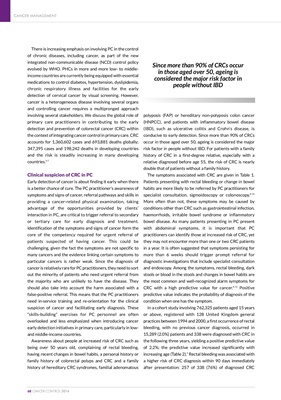
CANCER MANAGEMENT
CANCER CONTROL 2014 69
occurred within 3 months from the bleeding episode.9 Given
the fact that rectal bleeding affects 8-20% of the population
the characteristics of the bleeding requires attention:
painless bleeding or dark blood mixed with faeces are
significantly associated with CRC diagnosis.9,10 Changes in
bowel habits towards increased looseness or increased stool
frequency is more predictive than constipation.8 Research
evidence indicates that a combination of rectal bleeding, with
change in bowel habits, or one of these symptoms in persons
aged 60 and above should prompt urgent referral.8,10 A recent
review indicated rectal bleeding and weight loss as symptoms
with high positive predictive value for CRC diagnosis.11 Other
concomitant symptoms and signs with rectal bleeding
doubles the likelihood of a CRC diagnosis and, in contrast,
other symptoms in isolation have very low predictive value
for CRC.12
Symptoms of CRC differ depending on the location of the
tumour, from proximal to distal bowel. Those presenting with
proximal cancers may present without changes in bowel
habits, as the highly liquid stool may pass easily around even
large masses. Patients with cancers of the sigmoid and
rectum may pass bright red blood in stools which might be
mistaken by the patient as bleeding from haemorrhoids.
Difficulty on defecation or constipation can result from the
mass effect of tumours in the distal colon where the
stool is more bulky and unable to pass.
Early detection tests for CRC
Early detection tests for CRC include the chemical
faecal occult blood test (cFOBT), the immunochemical
FOBT (iFOBT), a digital rectal examination (DRE), a
double contrast barium enema, sigmoidoscopy,
endoscopic colonoscopy and virtual colonoscopy.
FOBT and DRE are feasible in PC, whereas the other
procedures can only be done in specialized services at
secondary or tertiary care centres by highly trained
specialists.
In a DRE, the anal canal and rectum are examined
with a lubricated, gloved finger. Although a DRE is
often included as part of a routine physical
examination, when patients complain of rectal bleeding or
other abdominal symptoms, it is not recommended as a
stand-alone test for CRC. This simple test, which is not
usually painful, can detect masses in the anal canal or lower
rectum. By itself, however, it is not a good test for detecting
CRC because its reach is limited and negative DRE does not
exclude CRC. A small amount of stool in the rectum when
doing a DRE is used by some general practitioners for cFOBT
or iFOBT. However, simply checking the stool obtained in this
fashion for bleeding with an FOBT is not an acceptable
method of early detection of CRC as the stool collected has
not recently transited through the colon and, therefore, is not
a representative sample of faeces. Research has shown that
this type of FOBT will miss more than 90% of CRC and polyps.
All patients with bright red blood in the stool should undergo
a DRE to assess if haemorrhoids are present. Any blood in the
stool in the absence of haemorrhoids should prompt an
immediate referral for colonoscopy.
Early detection tests such as FOBT could help general
practitioners in the early diagnosis of CRC. Such tests,
especially the iFOBT, should be accessible for PC
practitioners. The iFOBT is an early detection test that
detects occult (hidden) blood in the faeces. This test reacts
with globin, which is part of the human haemoglobin protein
Table 2: Frequency of colorectal cancer (CRC) among people with rectal bleeding in a cohort study in the United Kingdom
Age group Number of people with a People with CRC, diagnosed within Positive predictive
first episode of rectal bleeding 3 years from rectal bleeding value (%) for CRC diagnosis
15-44 years 5,489 8 0.15%
45-64 years 5,314 109 2.1%
65+ 4,494 221 4.9%
Total 15,289 338 2.2%
Adapted from reference
9
Table 1: Symptoms of colorectal cancer
‰ Blood in stools, from bright red (more distal tumours) to dark and
tarry (more proximal cancers) or dark stools.
‰ A persistent change in bowel habits, such as diarrhoea, increased
frequency of stools, constipation or narrowing of the stool that lasts
for more than 10 days.
‰ A feeling that one needs to have a bowel movement that is not
relieved by doing so.
‰ Feeling of incomplete evacuation after defecation.
‰ Inability to pass stools for a prolonged period of time (e.g. 1 week).
‰ Abdominal pain, cramps or bloating.
‰ Vomiting, especially after prolonged constipation.
‰ General weakness and fatigue.
‰ Unintended weight loss and/or loss of appetite.